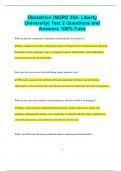Obstetrics (NURS 354- Liberty
University) Test 2 Questions and
Answers 100% Pass
What are the key components of prenatal care during the first trimester?
✔✔Key components include confirming pregnancy through lab tests and ultrasound, educating
the patient on early pregnancy signs, screening for genetic abnormalities, and establishing a
baseline for maternal and fetal health.
How does the nurse assess fetal well-being during prenatal visits?
✔✔The nurse assesses fetal well-being through monitoring fetal heart rate, performing
ultrasounds to assess fetal growth, and checking for fetal movement after 20 weeks of pregnancy.
What are the signs and symptoms of preeclampsia, and how should it be managed?
✔✔Signs of preeclampsia include high blood pressure, protein in the urine, edema, and
headaches. Management includes close monitoring of maternal and fetal status, medication to
control blood pressure, and sometimes early delivery if necessary.
What is the difference between gestational diabetes and pregestational diabetes?
1
,✔✔Gestational diabetes occurs during pregnancy and resolves after delivery, while
pregestational diabetes is a condition present before pregnancy that requires careful management
throughout pregnancy to prevent complications.
What is the purpose of the nonstress test (NST) in pregnancy?
✔✔The nonstress test is used to monitor fetal heart rate patterns in response to fetal movement,
helping to assess fetal well-being, especially in high-risk pregnancies.
What are the common discomforts of pregnancy, and what interventions can a nurse provide?
✔✔Common discomforts include nausea, vomiting, back pain, leg cramps, and heartburn.
Nurses can offer interventions such as dietary changes, proper body mechanics, and the use of
support garments or pillows.
What is the nurse's role in educating a pregnant woman about nutrition?
✔✔The nurse should educate the pregnant woman on balanced nutrition, the importance of folic
acid, iron supplements, and avoiding harmful substances like alcohol and tobacco. Additionally,
the nurse should guide portion control and the significance of proper hydration.
How does the nurse assess for signs of labor in a pregnant patient?
2
,✔✔Signs of labor include regular contractions, cervical dilation, rupture of membranes (water
breaking), and the presence of bloody show.
What are the stages of labor, and what is the nurse's role in each stage?
✔✔The stages of labor are the latent phase (early labor), active phase, transition phase, and the
delivery of the placenta. The nurse’s role includes monitoring contractions, supporting the
patient’s emotional needs, and preparing for delivery.
What is the difference between Braxton Hicks contractions and true labor contractions?
✔✔Braxton Hicks contractions are irregular, painless, and do not lead to cervical dilation, while
true labor contractions are regular, become more intense, and result in cervical dilation and
effacement.
What are the common indications for a cesarean section (C-section)?
✔✔Common indications for a cesarean section include fetal distress, breech presentation,
multiple gestation, placenta previa, or failure to progress in labor.
What are the potential complications of a prolonged labor, and how should the nurse manage
them?
3
, ✔✔Complications of prolonged labor can include uterine infection, fetal distress, and maternal
exhaustion. The nurse should monitor for signs of infection, support pain management, and assist
with interventions to promote labor progression.
What are the differences between an epidural block and a spinal block for pain relief during
labor?
✔✔An epidural block provides continuous pain relief during labor by delivering anesthetic
through a catheter inserted into the epidural space, while a spinal block provides immediate pain
relief for a shorter duration by injecting anesthesia directly into the spinal fluid.
What is the role of the nurse in providing emotional support during labor and delivery?
✔✔The nurse provides emotional support by offering encouragement, helping with relaxation
techniques, providing pain management options, and being a consistent and reassuring presence
for the patient and family.
How can a nurse help a patient prepare for postpartum care?
✔✔A nurse can help the patient prepare for postpartum care by educating on physical recovery,
breastfeeding, emotional changes, and self-care practices, including monitoring for signs of
complications such as hemorrhage or infection.
4




